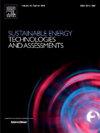Decoding outdoor thermal comfort: The role of location in urban canyon microclimate
IF 7.1
2区 工程技术
Q1 ENERGY & FUELS
Sustainable Energy Technologies and Assessments
Pub Date : 2024-11-20
DOI:10.1016/j.seta.2024.104095
引用次数: 0
Abstract
The Urban Heat Island (UHI) effect is a problem aggravated by climate change affecting many urban settings worldwide, with implications for thermal comfort, energy consumption and human health. The study of mitigation strategies is a field of interest for the research community. This study examines the impact of urban geometry and vegetation on creating microclimates in urban areas to improve thermal comfort and mitigate the UHI effect. The novelty is the cross-comparison of urban canyons in two cities with different latitudes and morphologies, Seville in Csa climate and 37°23′00″N latitude and Manta in BWh climate and 0°57′00″S latitude, to determine the most effective strategies for each location. The study uses ENVI-met to simulate 32 variations of typical urban canyon typologies. Results suggest that while air temperature shows minor fluctuations within the same city, thermal comfort differs significantly based on the geometry, orientation, and presence of vegetation. This difference is due to the variations in parameters that affect thermal comfort, such as relative humidity, solar radiation and wind speed. Vegetation improves thermal comfort in Seville while in Manta, where relative humidity is much higher, the addition of vegetation has a negative impact. Therefore, the recommended urban strategies for each city are different and should consider local climatological context and geographic location. The study highlights the need for tailored and context-specific urban design strategies to mitigate the impact of UHI in urban areas while addressing some general recommendations that can be considered in similar climates and urban contexts.
解码室外热舒适度:位置在城市峡谷小气候中的作用
城市热岛效应(UHI)是一个因气候变化而加剧的问题,影响到全球许多城市环境,并对热舒适度、能源消耗和人类健康产生影响。研究缓解策略是研究界关注的一个领域。本研究探讨了城市几何形状和植被对在城市地区创造微气候的影响,以改善热舒适度并缓解超高温影响。新颖之处在于对两个不同纬度和形态的城市--塞维利亚(Csa 气候,北纬 37°23′00″)和曼塔(BWh 气候,南纬 0°57′00″)--的城市峡谷进行了交叉比较,以确定每个地点最有效的策略。研究使用 ENVI-met 模拟了 32 种典型城市峡谷类型的变化。结果表明,虽然同一城市的气温波动很小,但热舒适度却因几何形状、朝向和植被的存在而大不相同。造成这种差异的原因是相对湿度、太阳辐射和风速等影响热舒适度的参数存在差异。在塞维利亚,植被可以改善热舒适度,而在相对湿度更高的曼塔,植被的增加会产生负面影响。因此,每个城市推荐的城市战略都不尽相同,应考虑当地的气候环境和地理位置。这项研究强调,有必要根据具体情况制定量身定制的城市设计策略,以减轻城市地区的超高温影响,同时提出了一些可在类似气候和城市环境下考虑的一般性建议。
本文章由计算机程序翻译,如有差异,请以英文原文为准。
求助全文
约1分钟内获得全文
求助全文
来源期刊

Sustainable Energy Technologies and Assessments
Energy-Renewable Energy, Sustainability and the Environment
CiteScore
12.70
自引率
12.50%
发文量
1091
期刊介绍:
Encouraging a transition to a sustainable energy future is imperative for our world. Technologies that enable this shift in various sectors like transportation, heating, and power systems are of utmost importance. Sustainable Energy Technologies and Assessments welcomes papers focusing on a range of aspects and levels of technological advancements in energy generation and utilization. The aim is to reduce the negative environmental impact associated with energy production and consumption, spanning from laboratory experiments to real-world applications in the commercial sector.
 求助内容:
求助内容: 应助结果提醒方式:
应助结果提醒方式:


